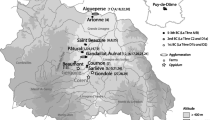Abstract
3000 years of agriculture were investigated in the valley of the Jhong river situated north of the main chain of the Himalayas in western Nepal at 3000–4000 m asl. During excavations carried out by the Institute for Prehistory of the University of Cologne (part of the DFG-Schwerpunktprogramm „Siedlungen und Staatenbildungen im tibetischen Himalaya”) in collaboration with the Nepal Department of Archaeology, more than 300 samples with plant remains were collected, dating from 1000 cal. B.C. up to today. Palaeoethnobotanical research was accompanied by investigations of today's methods of local agriculture and of the recent vegetation. Immigrants —perhaps from the Tibetan Plain—settled in the Jhong valley at the beginning of the first millennium B.C. Six cultivated taxa were already present in the first occupation period: probably two harvests per year were possible at this time as they still are today. During the following five archaeological periods, ten new cultivated taxa were found. In a burial cave of the second prehistoric period, fruits and seeds imported from the subtropical lowlands were found among the grave goods. From the more than 100 plant taxa identified in the botanical samples, more than 50 also occur in Europe.
Similar content being viewed by others
References
Miehe G (1982) Vegetationsgeographische Untersuchungen im Dhaulagiri- und Annapurna-Himalaya. Dissertationes Botanicae 66 (Vols 1,2), Vaduz
Schön W (1997) Investigation of settlement sites with house ruins and abandoned fields in Muktinath Valley, Nepal. In: Proceedings of the 13th Conference of the European Association of South Asian Archaeologists in Cambridge 1995. South Asian Archaeology: 841–850
Simons A (1996) Das Kollektivgrab Mebrak 63 im Mustang-Distrikt, Nepal. Eurasia Antiqua 2:383–395
Simons A (1997) The cave systems of Mustang-settlement and burial sites since prehistoric times. In: Proceedings of the 13th Conference of the European Association of South Asian Archaeologists in Cambridge 1995. South Asian Archaeology: 851–861
Simons A, Schön W (1998) Cave systems and terrace settlements in Mustang, Nepal. Settlement periods from prehistoric times to the present day. Beiträge zur allgemeinen und vergleichenden Archäologie 18: 27–47
Simons A, Schön W, Shresta SS (1994a) Preliminary report on the 1992 campaign of the team of the Institute of Prehistory, University of Cologne. Ancient Nepal 136: 51–75
Simons A, Schön W, Shresta SS (1994b) The prehistoric settlement of Mustang. First results of the 1993 archaeological investigation in cave systems and connected ruined sites. Ancient Nepal 137: 93–129
Simons A, Schön W, Shresta SS (1998) Archaeological research in Mustang. Report on the field work of the years 1994 and 1995 done by the Cologne University team. Ancient Nepal 140: 65–83
Author information
Authors and Affiliations
Rights and permissions
About this article
Cite this article
Knörzer, KH. 3000 years of agriculture in a valley of the High Himalayas. Veget Hist Archaebot 9, 219–222 (2000). https://doi.org/10.1007/BF01294636
Received:
Accepted:
Issue Date:
DOI: https://doi.org/10.1007/BF01294636




